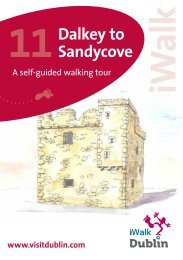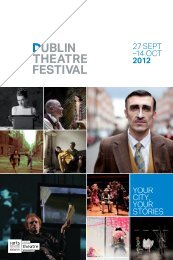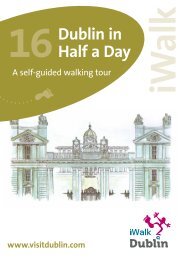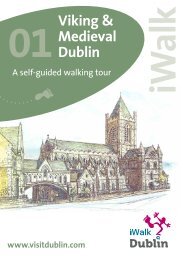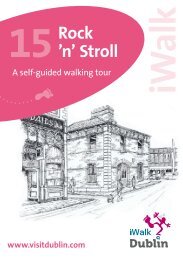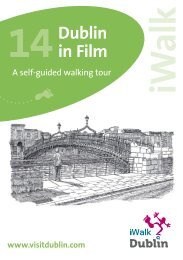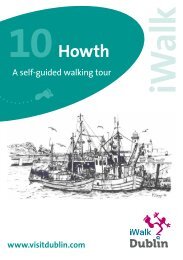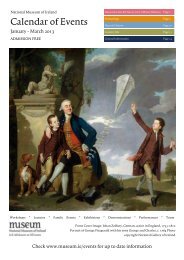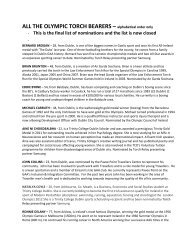iWalk 06 Castle & Cathedral - A self-guided walking tour - Visit Dublin
iWalk 06 Castle & Cathedral - A self-guided walking tour - Visit Dublin
iWalk 06 Castle & Cathedral - A self-guided walking tour - Visit Dublin
Create successful ePaper yourself
Turn your PDF publications into a flip-book with our unique Google optimized e-Paper software.
7<br />
Stop 7: Ship Street<br />
Now you are ready to leave the castle<br />
so proceed through the what is known<br />
as Ship Street Gate which today is the<br />
main ‘business’ and vehicle entrance<br />
into the castle and dates from c.1808.<br />
It was designed by Francis Johnston, the<br />
same architect who was responsible for<br />
the Chapel Royal. Watch out for Garda<br />
motorcycles who seem to constantly<br />
pass in and out like hornets from their<br />
nest. Immediately outside the gate stop<br />
at the archway which opens onto what<br />
is known as the <strong>Castle</strong> Steps.<br />
Stop 8: Golden Lane<br />
Walk along Little Ship Street by more sections of <strong>Dublin</strong>’s medieval walls and a protruding<br />
tower called Stanyhurst Tower. James Stanyhurst was one of the boy hostages taken by<br />
Silken Thomas’s men during his rebellion. Later he became Mayor of <strong>Dublin</strong> and Speaker<br />
of the Irish House of Commons. He also worked for a time in the <strong>Castle</strong> as ‘Recorder of<br />
the City’. He was father of Richard Stanyhurst whom we mentioned a few minutes ago<br />
when talking about Grace Weir’s panels. Some of the walls are in bad condition but will<br />
be restored in <strong>Dublin</strong> City Council’s new Conservation Plan for the walls and towers.<br />
The street follows the line of the underground River Poddle. When you reach the top<br />
of the road, taking care of any traffic, turn left into Bride Street. As you walk along<br />
the pavement and about 50m along the way you will reach an apartment block with<br />
something unusual about it. About halfway up and stretching the length of the façade<br />
are fixed large round sculptured disks. These are terracotta roundels or medallions, eight<br />
in all, depicting scenes taken from an 1899 edition of Jonathan Swift’s famous story<br />
“Gulliver’s Travels”. Jonathan Swift was Dean of St Patrick’s <strong>Cathedral</strong> where we are now<br />
heading. When you reach the next junction and when the traffic lights are in your favour,<br />
cross straight ahead over a street known as Golden Lane. The monument straight ahead<br />
commemorates Irish composer John Field.



